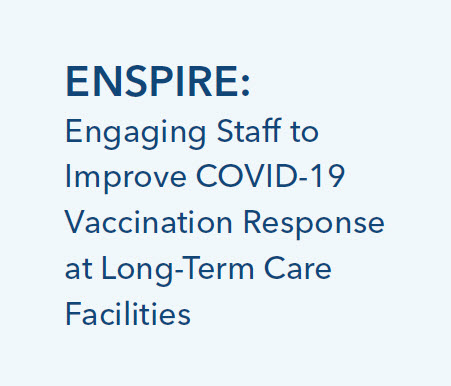About the ENSPIRE Study

ENSPIRE at a glance
ENSPIRE was a 3-year study at long-term care (LTC) centers in Georgia and Washington state.
Staff at these centers joined with the study team to codesign posters, brochures, videos, and other materials to promote the COVID-19 booster vaccine to LTC employees.
ENSPIRE compared the impact of these materials with the impact of materials from the CDC (Centers for Disease Control and Prevention) and other national organizations promoting the COVID-19 booster. The goal was to learn whether either set of materials:
- Increased COVID-19 booster vaccination rates among LTC staff
- Increased the willingness of LTC staff to promote the booster
ENSPIRE was funded by the Patient Centered Outcomes Research Institute, an independent nonprofit organization supporting research that can help patients and those who care for them make better-informed health care decisions.
Note: We use the term “centers” when discussing the care sites we collaborated with, including assisted living, skilled nursing, and independent living communities.
More about ENSPIRE
Each codesign team had 2 co-facilitators:
- A facilitator from the ENSPIRE study team
- A facilitator from the community
Co-facilitators from the community shared racial/ethnic identity with their codesign teams and were recruited and hired by the study team. All had experience working in or visiting LTC centers.
The codesign teams designed materials, selected communications channels, and received brief training on peer advocacy for promoting the COVID-19 booster.
ENSPIRE’s model was uniquely designed to be more rapid than most codesign efforts: Design and production took 10 to 12 weeks compared to 6 to 9 months for many other projects.1,2 The codesign process resulted in these deliverables:
- A set of core messages about COVID-19 booster vaccines
- Communications strategies transformed into professionallydesigned materials and ideas for dissemination at LTC centers
Once materials and plans were presented and endorsed, the LTC centers assumed responsibility for sharing the materials, with the ENSPIRE team providing technical support (phone calls, online meetings) for 3 months.
More about our methods
Our codesign process was based on the following methods and resources:
- Boot Camp Translation2
- Lean-inspired codesign3,4
- User-centered design frameworks for engaging communities and product users5
- Immunity Community interventions for decreasing vaccine hesitancy for childhood vaccines6
REFERENCES
1 “Boot Camp Translation (BCT),” University of Colorado Anschutz, medschool.cuanschutz.edu/family-medicine/research-and-innovation/research-methods/bootcamp-translation, accessed June 28, 2024.
2 Ned Norman et al. “Boot Camp Translation: A Method for Building a Community of Solution,” Journal of the American Board of Family Medicine, May-Jun 2013.
3 Jeff Gothelf. Lean UX: Applying Lean Principles to Improve User Experience. O'Reilly Media Inc., 2013.
4 Iain Smith et al. “Adapting Lean Methods to Facilitate Stakeholder Engagement and Co-design in Healthcare,” BMJ, January 28, 2020.
5 “Community-Led Co-design Kit,” Inclusive Design Research Centre, co-design.inclusivedesign.ca/, accessed September 10, 2024.
6 Jennie Schoeppe et al. “The Immunity Community: A Community Engagement Strategy for Reducing Vaccine Hesitancy,” Health Promotion Practice, September 2017.




